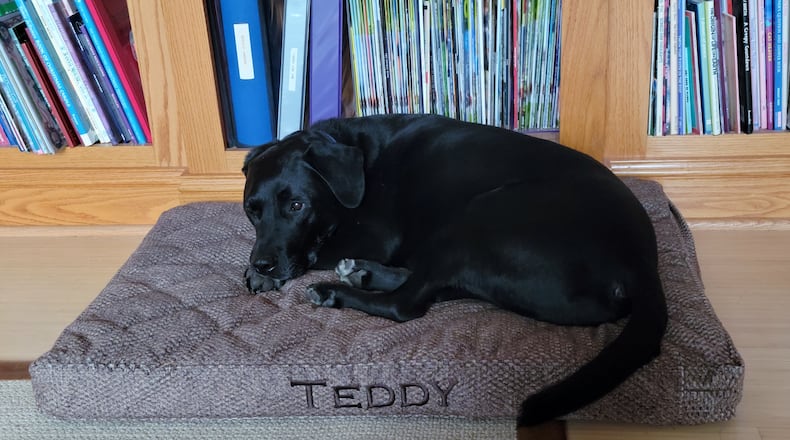It turns out our canine companions sleep more in the winter, too. And it isn’t necessarily bad for them either.
For you and me, the less sunlight we experience, the more our bodies produce the hormone melatonin, which can make us sleepier. The Mayo Clinic says, “The production and release of melatonin in the brain is connected to time of day, increasing when it’s dark and decreasing when it’s light.”
Like us, our canine companions also produce melatonin. And just like us, when dogs produce more melatonin from less light in the winter months, they will sleep more.
I often find Teddy, my family’s 8-year-old Lab, and Ed, my husband, snuggled up on the family room sofa in the winter — an event rarely seen in the summer months.
Remember, there’s nothing wrong with getting more sleep in the winter. Most researchers advise seven to 10 hours per night for humans. The American Kennel Club (AKC) says “dogs should spend 20% of their time being active, 30% of their time awake, but relaxing, and 50% of their time asleep.”
With the right amount of sleep, both you and your pup will fight illnesses better, maintain a healthy appetite and weight, and counteract the “winter blues.”
If you feel you and your pooch may be sleeping a little too much during these winter months, try some of these strategies:
First, maintain a predictable routine to provide a level of comfort for your furry friend. A typical routine includes having a time everyone wakes up, leaves for work and goes to sleep. It can also include when everyone eats, takes a walk or plays.
Pip, our 3-year-old cat, sets the “wake up” time at our house. Ed hasn’t set his alarm clock since the feline joined our family. When Pip starts squawking, Ed and Teddy start stretching as they roll out of their respective beds.
The routine continues with Teddy taking a quick trip outside to do his “business” and then back inside for breakfast. After the pooch and Pip have eaten, the three head downstairs. Ed starts his workday, checking his schedule for upcoming meetings, conference calls and the like. Teddy makes himself comfortable in the oversized pillow across from Ed’s desk.
Just after Ed eats lunch, he and Teddy, weather permitting, don their winter coats and take a short walk. Teddy’s fearless leader tries walking in the afternoon when the sun is at its highest peak and they both can take in all that sunshine.
After dinner or when the weather isn’t all that inviting, indoor activities like tug‑of‑war, find-the-treats and keep-the-ball-away-from Teddy are conducted. We also play Teddy’s favorite puzzle game, where he finds treats in a cupcake tin.
Finally, give your dog’s bed a thorough inspection. Does it need laundering? Holes patched? Is the “fluff” still fluffy? Most dogs, including Teddy, love snuggling in their beds after a busy winter’s day.
Teddy’s name is monogrammed on both of his soft, warm beds. That’s so no one will mistake whose bed they belong to. Unfortunately for Teddy, Pip can’t read.
LEARN MORE
5 most common sleeping positions for dogs:
1. The donut
2. Side sleeper
3. Lion pose
4. The Superman
5. The cuddle bug
SOURCE: petmd.com/dog/wellness/5-dog-sleeping
Karin Spicer is a member of The Dog Writers Association of America. She lives in Greene County with her family and two furry pets who inspire her. She can be reached at spicerkarin@gmail.com.
About the Author
